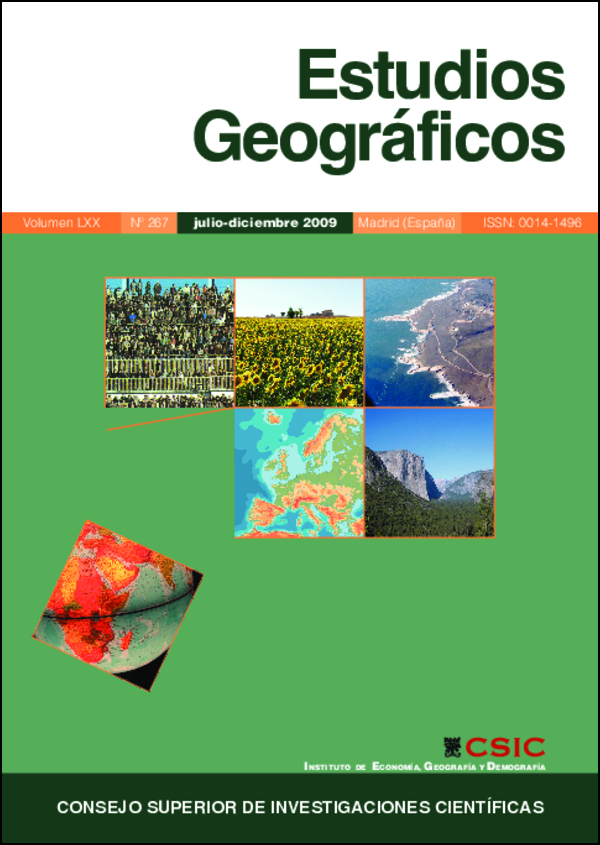Demographic Tendencies and Differences in the Balkans
DOI:
https://doi.org/10.3989/estgeogr.0464Keywords:
population projections, ageing, population structures, fertility, The BalkansAbstract
The Balkans, which had long been characterized by higher fertility and earlier mortality than the more western and northern parts of the European continent, have become demographically modern. They are not for that reason any less diverse. This is witnessed, for example, by the gap that separates Bulgaria, which has long made the demographic transition, and Albania, the Former Yugoslav Republic of Macedonia, or Kosovo, where the natural population growth exceeds by far the migratory deficit. It is also witnessed by the very large spectrum of degrees of aging. Political and economic changes in the Balkans, the crises that accompanied them, the doubts that they have caused concerning the collective future, have reinforced the general tendencies toward delayed marriage and fertility, as well as toward reduced marriage and fertility rates. This has de facto consolidated the tendency toward demographic aging. Migrations, especially the migrations directly or indirectly related to the conflicts in former Yugoslavia, have also contributed to the modification of the demographic landscape and to the altering of the dynamic of the affected populations. They have also had an effect on the ethnic distribution of these populations. In the Balkans, whose bases have been strongly shaken in the past twenty years, heavy fertility and mortality tendencies limit the spectrum of possible mid-to-long term futures. There are also important consequences on the socioeconomic plan. All this in a political context, internal and external, that is the source of many questions.
Downloads
References
Berber, M., Grbic, B., Pavkov, S. (2008): “Promene udela stanovniˇstva hrvatske i srpske nacionalne pripadnosti u Republici Hrvatskoj po gradovima i opˇstinama na osnovu rezultata popisa iz 1991. i 2001. godine”. Stanovniˇstvo (Belgrade), XLVI, 2, jul-dec. 2008, 23-62.
Mrdjen, S., Penev, G. (2003): “Balkans. Des comportements démographiques bouleversés”. Le Courrier des Pays de l’Est (Paris), 1035, mai 2003, 43-55.
Penev, G., ed. (2006): Stanovniˇstvo i doma’cinstva Srbije prema popisu 2002. godine. Republiˇ cki zavod za statistiku Srbije-Institut druˇstvenih nauka / Centar za demografska istraˇzivanja-Druˇstvo demografa Srbije, Beograd, 2006, 284 p.
Penev, G., ed. (2007): “Population projections of Serbia, 2002-2052” Survey Republic of Serbia (Belgrade), vol. XLVIII, 3/2007, 9-26.
Parant, A., ed (2007): Migrations, crises et conflits récents dans les Balkans. Actes de la conférence de Belgrade (27-29 octobre 2005), DemoBalk, 2006, 381 p.
Parant, A., Penev, G., Remikovic, S. (2008): Les Monténégrins au Monténégro: majoritaires hier, minoritaires demain? Démographie et Cultures-XVe Colloque de l’Aidelf (Québec, 25-29 août 2008).
Parant, A., Sardon, J.-P., (eds.) (2007): Les mutations de la décennie 1990 et l’avenir démographique des Balkans. Actes de la conférence de Sarajevo (10-13 mai 2000), DemoBalk, 2007, p. 369.
Downloads
Published
How to Cite
Issue
Section
License
Copyright (c) 2009 Consejo Superior de Investigaciones Científicas (CSIC)

This work is licensed under a Creative Commons Attribution 4.0 International License.
© CSIC. Manuscripts published in both the print and online versions of this journal are the property of the Consejo Superior de Investigaciones Científicas, and quoting this source is a requirement for any partial or full reproduction.
All contents of this electronic edition, except where otherwise noted, are distributed under a Creative Commons Attribution 4.0 International (CC BY 4.0) licence. You may read the basic information and the legal text of the licence. The indication of the CC BY 4.0 licence must be expressly stated in this way when necessary.
Self-archiving in repositories, personal webpages or similar, of any version other than the final version of the work produced by the publisher, is not allowed.















